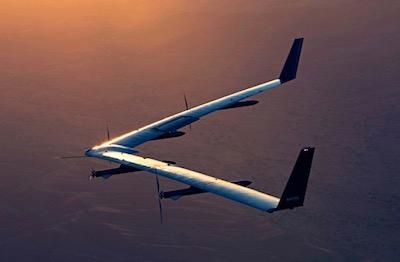Sat, Jul 01, 2017
The Aircraft Took Off, Flew And Landed Safely This Time Around
Facebook has completed the second flight of its Aquila drone it hopes to use to provide internet connectivity to remote areas of the world ... and this time the aircraft landed safely.

The 1 hour and 46 minute flight concluded with a smooth landing on the site prepared by the company at the Yuma Proving Ground in Arizona.
Writing on the Facebook blog, Martin Lois Gomez writes that the company learned some lessons from the first flight, which ended with the drone being damaged when it impacting terrain. Gomez writes that the Aquila was modified by:
- Adding “spoilers” to the wings, which help to increase drag and reduce lift during the landing approach
- Incorporating hundreds of sensors to gather new data
- Modifying the autopilot software
- Integrating new radios for the communication subsystem
- Applying a smoother finish on the plane
- Installing a horizontal propeller stopping mechanism to support a successful landing
The flight included lengthy test points at constant speed, heading, and altitude to measure the airplane’s drag. The data from these “trim shots,” as they’re called, will be used to refine aerodynamic models, which help in predicting the energy usage and thus optimize for battery and solar array size.
The aircraft's structure was also heavily instrumented with hundreds of sensors to collect data about how Aquila's shape responds to flight in real-time. These included hundreds of strain gauges and three-axis inertial measurement units (IMUs.) These tools serve to verify and refine our structural model, which predicts both the static shape of the airplane — designed to be very flexible to respond to wind gusts and maneuvers.
The aircraft landed autonomously on a 500-foot circle of level gravel about the consistency of rough sand. Aquila has no landing gear, per se, and instead lands on Kevlar pads glued to the bottom of the engine pods.
Now, the company will parse the data it collected on this flight to continue to refine and develop the aircraft for its intended use.
(Image courtesy of Facebook)
More News
He Attempted To Restart The Engine Three Times. On The Third Restart Attempt, He Noticed That Flames Were Coming Out From The Right Wing Near The Fuel Cap Analysis: The pilot repor>[...]
Make Sure You NEVER Miss A New Story From Aero-News Network Do you ever feel like you never see posts from a certain person or page on Facebook or Instagram? Here’s how you c>[...]
From 2009 (YouTube Edition): Leading Air Show Performers Give Their Best Advice for Newcomers On December 6th through December 9th, the Paris Las Vegas Hotel hosted over 1,500 air >[...]
Aero Linx: NASA ASRS ASRS captures confidential reports, analyzes the resulting aviation safety data, and disseminates vital information to the aviation community. The ASRS is an i>[...]
“For our inaugural Pylon Racing Seminar in Roswell, we were thrilled to certify 60 pilots across our six closed-course pylon race classes. Not only did this year’s PRS >[...]
 NTSB Final Report: Rutan Long-EZ
NTSB Final Report: Rutan Long-EZ ANN FAQ: Turn On Post Notifications
ANN FAQ: Turn On Post Notifications Classic Aero-TV: ICAS Perspectives - Advice for New Air Show Performers
Classic Aero-TV: ICAS Perspectives - Advice for New Air Show Performers ANN's Daily Aero-Linx (06.28.25)
ANN's Daily Aero-Linx (06.28.25) Aero-News: Quote of the Day (06.28.25)
Aero-News: Quote of the Day (06.28.25)



